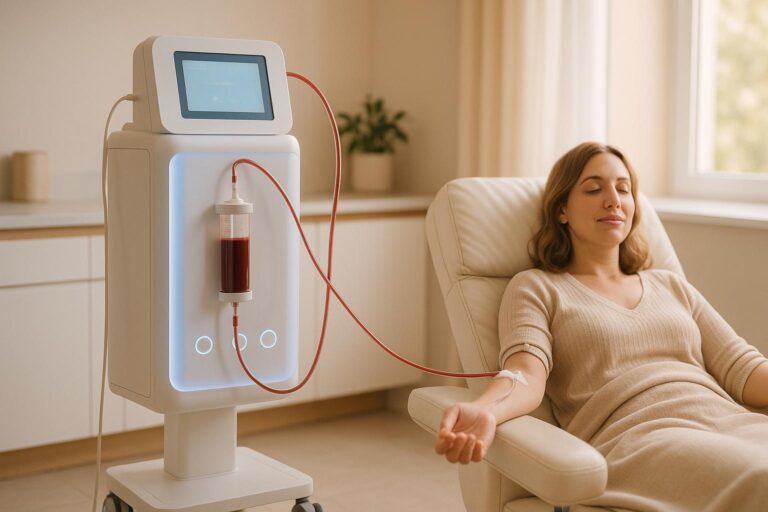Removing heavy metals from your body is possible with IV therapy, but monitoring is what makes it safe and effective. This process involves using chelating agents to bind and eliminate harmful metals like lead, mercury, and arsenic. However, without careful oversight, it can lead to complications like nutrient deficiencies or kidney stress. Here’s what you need to know:
- Key Risks: Heavy metals accumulate in tissues, not blood, making them hard to detect with standard tests. Symptoms like fatigue and brain fog often develop slowly.
- How IV Therapy Works: Chelators (like EDTA, DMPS, and DMSA) bind metals for removal through urine. This method is faster and more efficient than natural detox pathways.
- Why Monitoring Matters: Regular testing ensures safe metal removal, prevents nutrient loss, and protects organs like kidneys and liver during therapy.
- Pre-Therapy Testing: Baseline tests identify toxic metal levels, check essential minerals, and confirm the body’s readiness for treatment.
- During Therapy: Continuous monitoring tracks kidney function, electrolyte levels, and metal elimination to adjust treatment as needed.
- Advancements: AI, biosensors, and genetic testing are improving detection and tailoring therapy to individual needs.
Monitoring ensures IV therapy is safe and tailored to your body, avoiding complications while achieving effective detoxification.
How to Safely Administer IV Chelation 💉 | Step-by-Step Guide for Clinicians | Dr. Adam Sewell
Pre-Therapy Testing and Assessment
Before starting IV chelation therapy, an initial evaluation is crucial. This step ensures safety and provides a roadmap for treatment, serving as the foundation for monitoring progress throughout the therapy. These baseline tests play a key role in shaping the personalized treatment plans described below.
Baseline Heavy Metal Testing
Baseline heavy metal testing assesses the current levels of toxic metals and essential minerals in the body. One widely used method is provoked urine testing, where a small dose of a chelating agent helps release metals stored in tissues. This method often reveals hidden toxic metal burdens that standard blood tests might miss, as blood tests may not accurately reflect long-term tissue accumulation.
Testing for essential minerals like zinc, magnesium, and calcium follows to ensure these beneficial nutrients remain balanced during treatment. Additional evaluations, including kidney function (creatinine, blood urea nitrogen), liver health (enzyme levels), and cardiovascular checks (EKG, blood pressure), confirm the body’s readiness to safely eliminate metal–chelator complexes. Together, these assessments not only prepare the body for detoxification but also prioritize patient safety.
"Before beginning treatment, our board-certified physicians conduct a comprehensive evaluation, including: A thorough medical history review, Detailed laboratory tests to evaluate overall health, Baseline heavy metal level assessment."
Creating Custom Therapy Plans from Test Results
Using the data from baseline testing, treatment plans are customized for each individual. Since no two patients have identical heavy metal profiles, a one-size-fits-all approach simply doesn’t work.
The first step involves pinpointing which toxic metals are present and their concentrations. For example, lead exposure might be treated with EDTA chelation, while mercury toxicity could require a different agent. Based on these findings, personalized dosing and treatment schedules are established. Additionally, supportive therapies, such as IV nutrient formulations tailored to the patient’s mineral needs, help prevent deficiencies during the detoxification process.
"Evaluation covers heavy metals, cardiovascular health, and mineral levels to set a treatment baseline."
Treatment goals are clearly defined from the start, ensuring therapy continues until the desired detoxification outcomes are achieved.
Pre-Therapy Testing at Kinnection Clinic

Kinnection Clinic takes pre-therapy assessments to a deeper level. Their advanced diagnostic panels go beyond just measuring heavy metal levels, offering a holistic view of the patient’s health to better understand how toxicity may be affecting them.
This integrated approach aligns pre-therapy testing with each patient’s broader wellness goals. The clinic also considers any current treatments or potential interactions to craft a truly individualized plan. Based on the results, they develop comprehensive strategies that may include nutritional guidance and lifestyle adjustments to enhance the body’s natural detoxification and healing abilities.
"Ultimately, test results aim to determine if toxic exposures have occurred and guide treatment decisions."
Monitoring During IV Therapy
When undergoing IV chelation therapy, continuous monitoring is critical to ensure both safety and success. This process involves removing heavy metals from the body, which can trigger significant changes that need careful oversight. Here’s a closer look at what happens during this monitoring phase.
What to Monitor During Treatment
Keeping a close eye on several key factors is essential during each IV session:
- Vital signs: Blood pressure, heart rate, and temperature are checked regularly to detect any adverse reactions to the chelators and to confirm cardiovascular stability throughout the infusion.
- Kidney function: The kidneys play a central role in filtering out the metal-chelator complexes. Real-time monitoring of creatinine and blood urea nitrogen (BUN) levels ensures the kidneys are managing the extra workload. If these markers rise, adjustments to the treatment may be necessary.
- Electrolyte levels: Chelation therapy can disrupt the balance of critical minerals like sodium, potassium, calcium, and magnesium. Monitoring these levels is crucial to avoid complications such as irregular heart rhythms or muscle issues.
- Heavy metal levels: Periodic blood and urine tests measure how effectively the therapy removes metals like lead, mercury, or cadmium. These results help determine if the treatment plan is working or needs tweaking.
- Liver enzymes: Since the liver assists in processing chelating agents, elevated enzyme levels can signal stress. In such cases, the dosage may need to be reduced, or treatment might be temporarily paused.
How Often to Test
Testing is scheduled to capture immediate and delayed effects of the therapy:
- Before each session: Pre-infusion tests establish baseline values, check vital signs, and confirm the patient is ready for treatment. This step ensures kidney function remains stable.
- 6 hours post-infusion: This is when metal mobilization peaks, making it a key time to detect any acute complications.
- 24 hours post-infusion: Testing at this stage evaluates how effectively the body is eliminating the mobilized metals. Urine samples often show the highest concentrations during this period.
- 48 to 72 hours post-infusion: Follow-up tests track recovery and identify any delayed reactions. These results provide insights into how long the detox effects last after each session.
The frequency of testing may vary depending on the patient’s health. Those with kidney issues or complex medical conditions may require more frequent checks, while healthier individuals might need less intensive monitoring as treatment progresses.
Keeping Patients Safe During Therapy
Safety is a top priority, and multiple layers of protection are in place to ensure patients remain well during therapy:
- Professional oversight: Board-certified physicians and trained nursing staff monitor patients throughout the infusion process, ready to respond to any changes in condition.
- Real-time monitoring technology: Advanced tools track vital signs continuously, with automated alerts for any abnormalities. This is especially useful during the first few hours when metal mobilization is at its peak.
- Emergency protocols: Medical teams rehearse clear action plans for handling complications, from minor allergic reactions to serious issues like electrolyte imbalances. These protocols ensure rapid and effective responses.
- Patient education: Patients are taught to recognize symptoms that might indicate a problem, such as unusual fatigue, changes in urination patterns, or new discomforts. This collaboration between patients and medical staff adds another layer of safety.
- Dosage adjustments: Based on test results, dosages are fine-tuned to balance effective detoxification with patient safety. For instance, adjustments are made if kidney function markers show signs of stress or if electrolyte levels shift.
sbb-itb-d9e542d
Reading Results and Adjusting Treatment
Interpreting test results is key to fine-tuning IV therapy. The goal? Maximize the removal of heavy metals while safeguarding the patient’s overall health.
Measuring Treatment Success
Success is measured by comparing lab results and patient symptoms to pre-treatment baseline levels. Blood and urine tests provide a clear view of how well heavy metals are being eliminated. These tests, combined with a close watch on patient symptoms, offer valuable insights into the effectiveness of the treatment.
If test results show incomplete detoxification or reveal nutrient imbalances, adjustments to the chelation protocol become necessary to optimize outcomes.
Changing Chelation Protocols
Chelation protocols are adjusted based on test outcomes. A common modification involves switching chelating agents. For instance:
- EDTA is often used to target lead and aluminum.
- DMPS and DMSA are preferred for mercury and lead removal.
In some cases, the method of administration may also change. For example, switching from IV DMPS to oral DMSA may be recommended depending on the patient’s needs.
These adjustments are part of the ongoing monitoring process, ensuring that the treatment aligns with the patient’s specific heavy metal levels and response. The goal is always to provide safe and effective therapy tailored to the individual.
Preventing Nutrient Loss
Chelation therapy can unintentionally deplete essential minerals like zinc, magnesium, and calcium, which are critical for health. Routine monitoring of these nutrients is essential to prevent deficiencies that could undermine the patient’s well-being.
Supplementation strategies are based on test results. For instance, IV nutrient therapy might be administered either alongside or between chelation sessions. This ensures the body retains the nutrients it needs while toxic metals are being removed.
Timing is everything when it comes to supplementation. Essential minerals are usually replenished after chelation sessions to avoid interfering with the detoxification process. This careful scheduling helps maintain the body’s nutritional balance throughout treatment.
New Research in Heavy Metal Monitoring
Recent advancements are pushing the boundaries of heavy metal detection, aiming to improve the safety and effectiveness of IV therapy. By building on established methods, researchers are exploring cutting-edge technologies that promise more precise monitoring and innovative treatment options.
New Monitoring Technology
Scientists are now using artificial intelligence to analyze biomarkers in blood and urine. With machine learning, subtle shifts in heavy metal levels can be identified, allowing for more tailored treatment plans.
Biosensors are also gaining traction as a tool for continuous monitoring. Researchers are refining analytical techniques, such as advanced mass spectrometry, to detect even trace amounts of metals earlier – potentially enabling timely interventions.
Wearable sensors are another area of interest. These devices monitor oxidative stress and inflammation biomarkers, offering real-time data that bridges the gap between laboratory tests and daily health monitoring.
New Supporting Therapies
In addition to advancements in technology, new therapies are being explored to enhance detoxification. For instance, natural antioxidants like glutathione are being studied for their ability to support liver function and protect cells when paired with chelation treatments.
Improved nutrient delivery systems, such as liposomal formulations, are under evaluation for their ability to boost the absorption of vitamins and minerals essential to detoxification. Meanwhile, infrared saunas are being investigated for their role in promoting toxin elimination through sweat.
Another promising approach involves targeted probiotics. These are being examined for their potential to bind heavy metals in the gut, aiding natural excretion – a strategy that could be especially helpful for individuals with digestive issues.
Future of Personalized Care
Genetic research is opening new doors for personalized detox strategies. Genetic testing now offers insights into how individual differences in detoxification enzymes can influence treatment plans.
One exciting development is the concept of precision chelation. By combining genetic data, toxin exposure history, and real-time monitoring, treatments can be fine-tuned for maximum effectiveness. At Kinnection Clinic, genetic information is being integrated with broader strategies like hormone optimization, nutritional support, and lifestyle adjustments to address toxicity at its core.
Research is also focusing on combination therapies, blending IV chelation with nutritional and lifestyle interventions for better results. The future may even include continuous monitoring systems capable of dynamically adjusting treatment protocols based on the patient’s real-time response. These advancements are paving the way for safer, more personalized approaches to heavy metal detox through IV therapy.
Conclusion
Keeping a close eye on heavy metals during IV therapy is crucial for ensuring treatments are both safe and effective. Proper monitoring can mean the difference between successful detoxification and potential complications.
Starting with thorough pre-therapy testing helps establish baseline levels, providing a clear roadmap for creating tailored and safe treatment plans. This careful approach lays the groundwork for advancements in therapy.
During the course of IV therapy, ongoing monitoring plays a key role. Regular testing allows for real-time adjustments to chelation protocols, helping avoid issues like over-mobilization of toxins or nutrient imbalances.
Key Points
Emerging technologies, such as AI and biosensors, are paving the way for more accurate heavy metal detection and improved treatment precision.
Personalized protocols remain the cornerstone of safe and effective IV therapy. Each person’s genetic background, toxin exposure, and overall health must shape their treatment plan. A one-size-fits-all approach simply doesn’t account for the individual differences that impact how people respond to chelation therapy.
The importance of professional oversight cannot be overstated. Combining advanced monitoring tools with clinical expertise creates the ideal conditions for successful heavy metal detoxification. At Kinnection Clinic, this approach integrates cutting-edge testing with functional medicine principles to address the root causes of metal toxicity while promoting overall wellness. This reflects our dedication to offering personalized, safe care at every stage of treatment.
Looking ahead, the future of heavy metal monitoring lies in precision medicine. As technology evolves, patients can anticipate even more tailored and adaptive care, ensuring their detoxification process aligns with their unique needs.
Achieving successful heavy metal detoxification requires blending advanced technology, clinical skill, and individualized care. This combination ensures patients get the most out of their treatments while maintaining the highest safety standards. With ongoing research and current best practices, IV therapy continues to evolve, reinforcing safe detoxification as the cornerstone of effective care.
FAQs
How do AI and biosensors improve the monitoring of heavy metals during IV therapy?
AI and biosensors are transforming the way heavy metals are monitored during IV therapy by offering real-time, precise detection of metal levels in the body. With advanced biosensors working alongside AI algorithms, data can be analyzed swiftly and with high accuracy, delivering actionable insights that guide treatment decisions.
This approach ensures detoxification protocols can be fine-tuned to meet individual patient needs, enhancing both the safety and effectiveness of the therapy. By combining advanced technology with personalized care, this method supports improved outcomes for patients undergoing heavy metal detoxification.
What are the risks of not monitoring kidney function and electrolyte levels during IV chelation therapy?
Failing to keep an eye on kidney function and electrolyte levels during IV chelation therapy can lead to some serious health problems. These include kidney damage or even failure, electrolyte imbalances like high potassium or low sodium, and fluid overload, which can strain the heart or worsen kidney issues.
Chelation agents are filtered through the kidneys, so without proper monitoring, the chances of acute kidney injury or worsening chronic kidney disease go up significantly. Regular check-ins with a healthcare professional are key to reducing these risks and ensuring the therapy is carried out safely and effectively.
How does genetic testing help personalize IV therapy for heavy metal detoxification?
Genetic testing can uncover particular DNA variations that impact how your body handles and clears heavy metals. For instance, some genetic markers may influence glutathione production or metal transport – both essential processes for detoxifying the body.
With insights from your genetic profile, healthcare providers can fine-tune IV therapy plans to better suit your individual needs. This tailored approach not only enhances the treatment’s effectiveness but also minimizes potential risks, ensuring it aligns with how your body works best.



